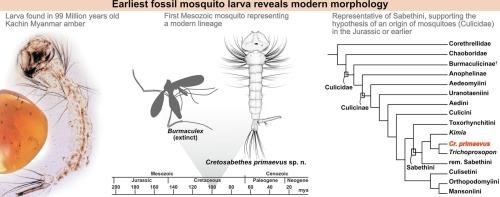在9900万年前的琥珀中发现的第一个具有现代形态的蚊子幼虫化石,揭示了蚊子的进化史(双翅目:库蚊科)
IF 7.2
1区 地球科学
Q1 GEOSCIENCES, MULTIDISCIPLINARY
引用次数: 0
摘要
蚊子(双翅目:蚊科)被假设起源于侏罗纪时期,大约2.01 - 1.45亿年前,主要基于它们的姐妹类群——超蚊科(幻蚊)的化石证据。然而,库蚊科如此早期起源的直接证据目前尚不存在。已知最古老的蚊子化石都是成年蚊子,从大约9900万年前的白垩纪琥珀沉积物中发现,它们的形态与现代蚊子有很大不同,被认为是已经灭绝的Burmaculicinae谱系的代表。在这里,我们报告了一个化石的发现,它既代表了保存在琥珀中的第一个蚊子幼虫,也代表了中生代的第一个未成熟蚊子,被命名为一个新属和新种Cretosabethes primaevus Amaral &; Borkent gen. et sp. n.标本具有典型的蚊子幼虫形态,可以自信地确定为Sabethini的一个分支,一个有许多现存代表的谱系。这一发现为库蚊科的侏罗纪起源提供了强有力的支持,并表明蚊子的幼虫形态至少在过去的9900万年中保持相对保守。本文章由计算机程序翻译,如有差异,请以英文原文为准。

First fossil mosquito larva in 99-million-year-old amber with a modern type of morphology sheds light on the evolutionary history of mosquitoes (Diptera: Culicidae)
Mosquitoes (Diptera: Culicidae) have been hypothesized to have originated during the Jurassic Period, about 201–145 million years ago, primarily based on fossil evidence from their sister group, Chaoboridae (phantom midges). However, direct evidence for such an early origin of Culicidae is currently absent. The oldest known mosquito fossils, all adults and recovered from Cretaceous amber deposits about 99 million years ago, display morphologies that differ substantially from modern forms and are regarded as representatives of an extinct lineage, Burmaculicinae. Here we report the discovery of a fossil that represents both the first mosquito larva preserved in amber and the first immature mosquito from the Mesozoic Era, named as a new genus and species Cretosabethes primaevus Amaral & Borkent gen. et sp. n. The specimen exhibits typical mosquito larval morphology and can be confidently identified as an ingroup of Sabethini, a lineage with numerous extant representatives. This finding provides strong support for the Jurassic origin of Culicidae and suggests that the larval morphology of mosquitoes has remained relatively conserved for at least the past 99 million years.
求助全文
通过发布文献求助,成功后即可免费获取论文全文。
去求助
来源期刊

Gondwana Research
地学-地球科学综合
CiteScore
12.90
自引率
6.60%
发文量
298
审稿时长
65 days
期刊介绍:
Gondwana Research (GR) is an International Journal aimed to promote high quality research publications on all topics related to solid Earth, particularly with reference to the origin and evolution of continents, continental assemblies and their resources. GR is an "all earth science" journal with no restrictions on geological time, terrane or theme and covers a wide spectrum of topics in geosciences such as geology, geomorphology, palaeontology, structure, petrology, geochemistry, stable isotopes, geochronology, economic geology, exploration geology, engineering geology, geophysics, and environmental geology among other themes, and provides an appropriate forum to integrate studies from different disciplines and different terrains. In addition to regular articles and thematic issues, the journal invites high profile state-of-the-art reviews on thrust area topics for its column, ''GR FOCUS''. Focus articles include short biographies and photographs of the authors. Short articles (within ten printed pages) for rapid publication reporting important discoveries or innovative models of global interest will be considered under the category ''GR LETTERS''.
 求助内容:
求助内容: 应助结果提醒方式:
应助结果提醒方式:


